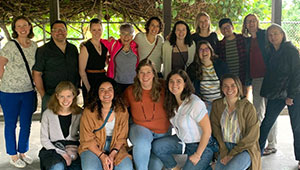Preventive Medicine
Research overview
Research is often lauded for finding life-saving treatments for diseases like cancer or diabetes. But consider the impact of preventing such illnesses from developing in the first place. It’s hard to describe the value of stopping illness or injury from happening. Yet that’s the goal of research on preventive care.
Most Kaiser Permanente Washington scientists study prevention, whether their work focuses on promoting health by influencing individual behavior, building sound prevention services into everyday clinical care, designing smart health coverage, or all three. By conducting their research at Kaiser Permanente Washington—which combines care and coverage—our researchers have access to data from a large, stable population over time, allowing them to discover which approaches to prevention work best.
Examples include research in areas such as:
Evidence-based practice reviews
A team of researchers at Kaiser Permanente Washington Health Research Institute (KPWHRI) produces reviews of scientific evidence that policymakers at the Centers for Medicare & Medicaid Services and the U.S. Preventive Services Task Force and others use in health care decision-making. We do this work as part of the Kaiser Permanente Research Affiliates Evidence-based Practice Center, one of 13 centers nationwide that are sponsored by the federal Agency for Healthcare Research and Quality.
Immunization
We’re improving the safety and effectiveness of vaccines through clinical trials, and we’re monitoring how well each year’s new flu vaccines are working. In addition, we’re studying ways to better inform parents about the benefits and potential harms of childhood vaccines, to improve their uptake.
Drug safety
We’re working on several fronts to help ensure the safety of prescription drugs and other medical treatments. For example, we play a leading role in the Food and Drug Administration’s Sentinel program to monitor the safety of medical products through routinely collected electronic health care data. We’re exploring ways to improve the safety of prescribing opioid pain medications. And we often study the safety of drugs commonly used to prevent chronic conditions like heart disease, cancer, and depression.
Screening
Prevention also includes screening to detect disease before symptoms appear, to identify and treat disease at an earlier stage. Our research is improving the effectiveness of cancer screening programs so people get the appropriate tests when needed based on their particular risks. Our research is also aimed at improving clinical screening for behavioral risks such as smoking, suicidal thoughts, alcohol use disorders, and poor eating and exercise habits.
Health promotion
Our research in areas such as smoking cessation, healthy diet, and chronic illness care finds new ways to encourage individuals to adopt and maintain healthier lifestyles. At the same time, we’re exploring ways to reach large populations through the use of phone-based programs, websites, and mobile technologies.
Recent publications on Preventive Medicine
Rossom RC, Simon GE. Screening for suicide risk is predicting the future, not diagnosing the present. Jt Comm J Qual Patient Saf. 2023 Sep 20:S1553-7250(23)00228-3. doi: 10.1016/j.jcjq.2023.09.006. [Epub ahead of print]. PubMed
Onega T, Abraham L, Miglioretti DL, Lee CI, Henderson LM, Kerlikowske K, Tosteson ANA, Weaver D, Sprague BL, Bowles EJA, di Florio-Alexander RM. Digital mammography and digital breast tomosynthesis for detecting invasive lobular and ductal carcinoma. Breast Cancer Res Treat. 2023 Dec;202(3):505-514. doi: 10.1007/s10549-023-07051-6. Epub 2023 Sep 11. PubMed
Lee JM, Ichikawa LE, Wernli KJ, Bowles EAJ, Specht JM, Kerlikowske K, Miglioretti DL, Lowry KP, Tosteson ANA, Stout NK, Houssami N, Onega T, Buist DSM. Impact of surveillance mammography intervals less than one year on performance measures in women with a personal history of breast cancer. J Korean Radiol. 2023 Aug;24(8):729-738. doi: 10.3348/kjr.2022.1038. PubMed
Sprague BL, Coley RY, Lowry KP, Kerlikowske K, Henderson LM, Su YR, Lee CI, Onega T, Bowles EJA, Herschorn SD, diFlorio-Alexander RM, Miglioretti DL. Digital breast tomosynthesis versus digital mammography screening performance on successive screening rounds from the Breast Cancer Surveillance Consortium. Radiology. 2023;307(5):e223142. doi: 10.1148/radiol.223142. PubMed
Balderson BH, Gray SL, Fujii MM, Nakata KG, Williamson BD, Cook AJ, Wellman R, Theis MK, Lewis CC, Key D, Phelan EA. A health-system-embedded deprescribing intervention targeting patients and providers to prevent falls in older adults (STOP-FALLS trial): Study protocol for a pragmatic cluster-randomized controlled trial. Trials. 2023 May 11;24(1):322. doi: 10.1186/s13063-023-07336-7. PubMed
Researchers in Preventive Medicine
 Paula Lozano, MD, MPHSenior Investigator; Director, ACT Center |
 Katharine A. Bradley, MD, MPHSenior Investigator |
 Jessica Chubak, PhDSenior Investigator |
 Dori E. Rosenberg, PhD, MPHSenior Investigator |
 Karen Wernli, PhDSenior Investigator |
 Erin J. Bowles, MPHDirector, Collaborative Science |
 Melissa L. Anderson, MSPrincipal Collaborative Biostatistician |
 Paula R. Blasi, MPHSenior Collaborative Scientist |
 Joseph E. Glass, PhD, MSWSenior Investigator |
 Julie E. Richards, PhD, MPHAssociate Investigator |
 Yu-Ru Su, PhDAssociate Biostatistics Investigator |
 Annie Hoopes, MD, MPHAssistant Investigator |
 Pamela A. Shaw, PhD, MSSenior Biostatistics Investigator |
 Claire Allen, MPHManager, Collaborative Science |
 Nicole M. Gatto, PhD, MPHPrincipal Collaborative Scientist |
 Kelsey Stefanik-Guizlo, MPHCollaborative Scientist |
 Theresa E. Matson, PhD, MPHCollaborative Scientist |
 Meagan C. Brown, PhD, MPHAssistant Investigator |
 Nora Henrikson, PhD, MPHAssociate Investigator |










